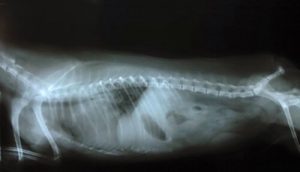Wobbler Syndrome: Causes, Symptoms, and Treatment


Written and verified by the lawyer Francisco María García
Wobbler syndrome, or cervical spondylomyelopathy (CSM), is a spinal disease that mostly affects large dogs. Early diagnosis is important to prevent any conditions such as disabilities and neurological deficits. In this article, you can learn about we’re going to tell you about its causes, symptoms, and how to treat it.
Traits and symptoms of wobbler syndrome
Wobbler syndrome includes a variety of degenerative disorders that do neurological damage and prevent proper motor function. It develops when the spinal cord and neck nerves are compressed too much (myelopathy).
It only becomes visible when the dog starts to have constant neck pain. Unfortunately, it’s a vague symptom that’s hard to spot early on. That’s why most diagnoses take place after the more intense neurological issues appear, such as wobbling and losing their balance easily. Here are the main symptoms of wobbler syndrome:
- Unstable, wobbly walking. They generally take short steps.
- Pain or stiffness in the neck.
- Loss of muscle mass in shoulders and front legs.
- Fatigue and weakness.
- Partial or total paralysis.
- Swelling in front and hind legs.
- Trouble getting up and moving around.
Wobbler syndrome: causes and genetic factors
Myelopathy is known for developing due to a weakened bone structure around the spinal cord. It’s usually a result of bone malformation or a dislocated intervertebral disc. What we don’t know is the origin of wobbler syndrome. However, as far as we know, and according the information we currently have from clinical cases, is that genetics play are a key factor.
Nearly 50% of all diagnoses take place in Dobermans, Mastiffs, and Great Danes. Other breeds that are likely to get this disease are Irish wolfhounds, Basset Hounds, and Rottweilers.

Another key factor is the size of the dog. Scientists think that the rapid growth of large dogs makes them more vulnerable to degenerative diseases. Almost 70% of wobbler syndrome diagnoses appear in large or massive dogs. However, there have been some cases with small or miniature breeds like Yorkshires, Pinschers, and Chihuahuas.
Diagnosing wobbler syndrome in dogs
Vets diagnose wobbler syndrome differentially by looking at a dog’s spine and vertebrae. They use X-rays, digital tomography, MRI, and myelography. A vet will usually ask to run blood and urine tests to rule out other more common diseases. They’ll also look at your dog’s medical history and genetic profile.
Treatment for wobbler syndrome in dogs
Treatment involves surgery, as a way to reduce pressure on the spinal cord. Its effectiveness depends on the dog’s physical state and where exactly the compression is taking place. When your pet is very weak or old, a vet might decide not to operate on him. The chances of death or irreversible neurological damage are so high that it’s not worth the risk.

They usually do walking therapy in these cases to help reduce pain and improve the dog’s quality of life.
Recovering from surgery
To guarantee a recover fully, dogs need a 2-3-month rest period. You have to make sure they don’t jump or run, because it could stop their bones from fusing back together. In the meantime, make sure they have soft, squishy things to lay on. It’s usually best to have your dog under observation to make sure they don’t get sores or other injuries.
Physical therapy is a great way to speed up the recovery and strengthen their body. It can also stop them from losing muscle mass or atrophying due to their lack of movement and exercise.
Is it possible to prevent wobbler syndrome?
Because wobbler syndrome has a genetic origin, there’s no specific way to prevent it. What you can do is strengthen your dog’s body and immune system so that they stay healthy. This is just one more reason it’s important to make sure they have a balanced diet and do physical activities on a regular basis. You also have to use preventative medicine and take them to the vet often.
Wobbler syndrome, or cervical spondylomyelopathy (CSM), is a spinal disease that mostly affects large dogs. Early diagnosis is important to prevent any conditions such as disabilities and neurological deficits. In this article, you can learn about we’re going to tell you about its causes, symptoms, and how to treat it.
Traits and symptoms of wobbler syndrome
Wobbler syndrome includes a variety of degenerative disorders that do neurological damage and prevent proper motor function. It develops when the spinal cord and neck nerves are compressed too much (myelopathy).
It only becomes visible when the dog starts to have constant neck pain. Unfortunately, it’s a vague symptom that’s hard to spot early on. That’s why most diagnoses take place after the more intense neurological issues appear, such as wobbling and losing their balance easily. Here are the main symptoms of wobbler syndrome:
- Unstable, wobbly walking. They generally take short steps.
- Pain or stiffness in the neck.
- Loss of muscle mass in shoulders and front legs.
- Fatigue and weakness.
- Partial or total paralysis.
- Swelling in front and hind legs.
- Trouble getting up and moving around.
Wobbler syndrome: causes and genetic factors
Myelopathy is known for developing due to a weakened bone structure around the spinal cord. It’s usually a result of bone malformation or a dislocated intervertebral disc. What we don’t know is the origin of wobbler syndrome. However, as far as we know, and according the information we currently have from clinical cases, is that genetics play are a key factor.
Nearly 50% of all diagnoses take place in Dobermans, Mastiffs, and Great Danes. Other breeds that are likely to get this disease are Irish wolfhounds, Basset Hounds, and Rottweilers.

Another key factor is the size of the dog. Scientists think that the rapid growth of large dogs makes them more vulnerable to degenerative diseases. Almost 70% of wobbler syndrome diagnoses appear in large or massive dogs. However, there have been some cases with small or miniature breeds like Yorkshires, Pinschers, and Chihuahuas.
Diagnosing wobbler syndrome in dogs
Vets diagnose wobbler syndrome differentially by looking at a dog’s spine and vertebrae. They use X-rays, digital tomography, MRI, and myelography. A vet will usually ask to run blood and urine tests to rule out other more common diseases. They’ll also look at your dog’s medical history and genetic profile.
Treatment for wobbler syndrome in dogs
Treatment involves surgery, as a way to reduce pressure on the spinal cord. Its effectiveness depends on the dog’s physical state and where exactly the compression is taking place. When your pet is very weak or old, a vet might decide not to operate on him. The chances of death or irreversible neurological damage are so high that it’s not worth the risk.

They usually do walking therapy in these cases to help reduce pain and improve the dog’s quality of life.
Recovering from surgery
To guarantee a recover fully, dogs need a 2-3-month rest period. You have to make sure they don’t jump or run, because it could stop their bones from fusing back together. In the meantime, make sure they have soft, squishy things to lay on. It’s usually best to have your dog under observation to make sure they don’t get sores or other injuries.
Physical therapy is a great way to speed up the recovery and strengthen their body. It can also stop them from losing muscle mass or atrophying due to their lack of movement and exercise.
Is it possible to prevent wobbler syndrome?
Because wobbler syndrome has a genetic origin, there’s no specific way to prevent it. What you can do is strengthen your dog’s body and immune system so that they stay healthy. This is just one more reason it’s important to make sure they have a balanced diet and do physical activities on a regular basis. You also have to use preventative medicine and take them to the vet often.
This text is provided for informational purposes only and does not replace consultation with a professional. If in doubt, consult your specialist.








